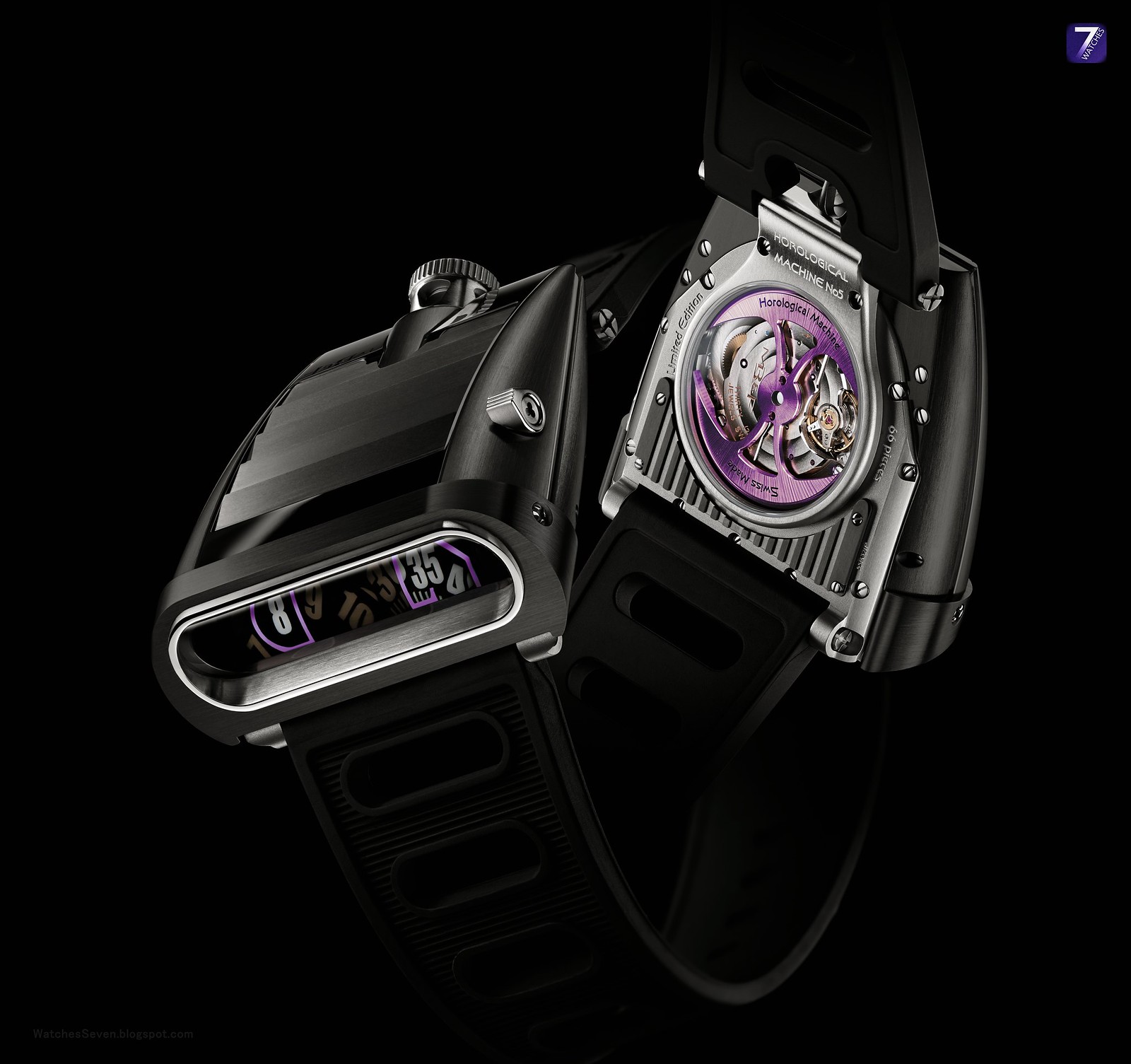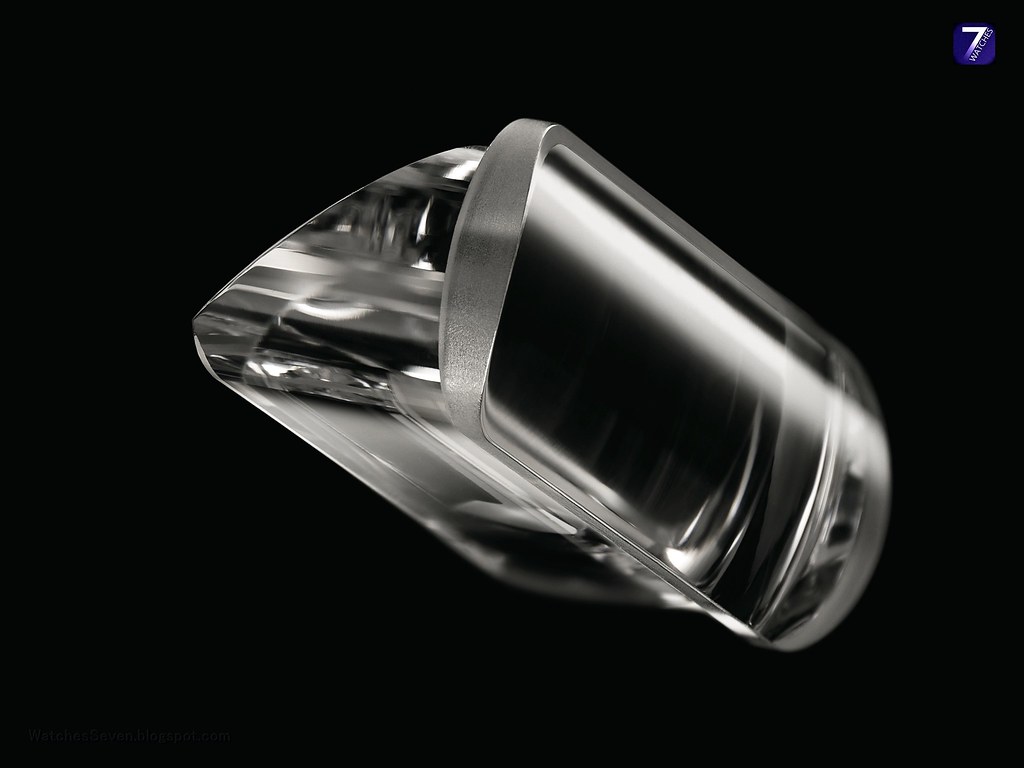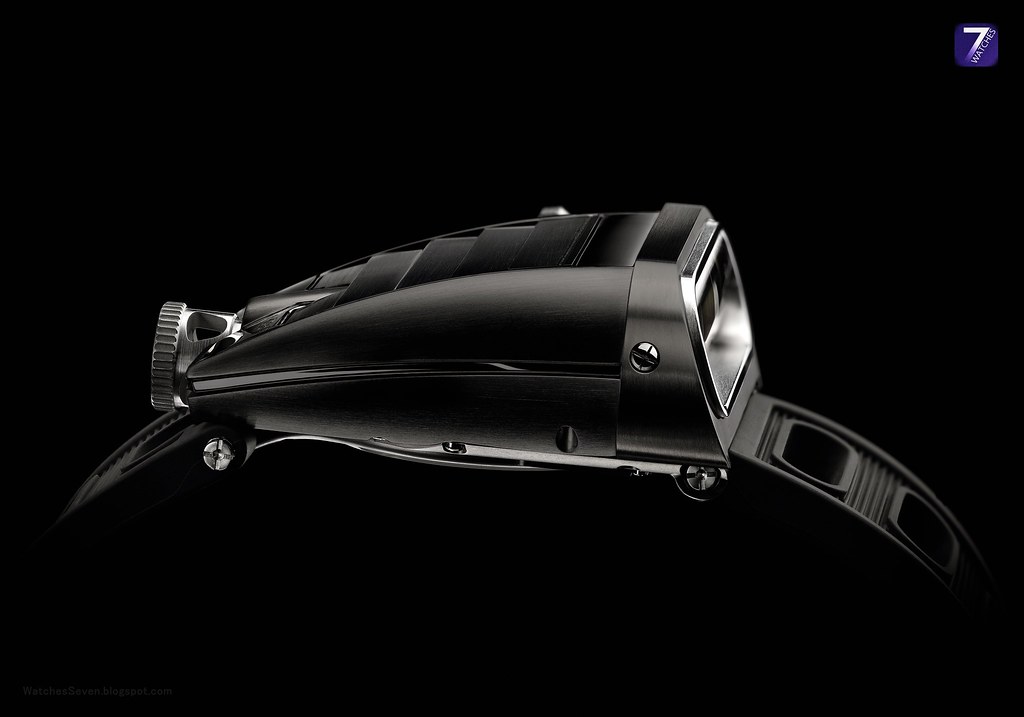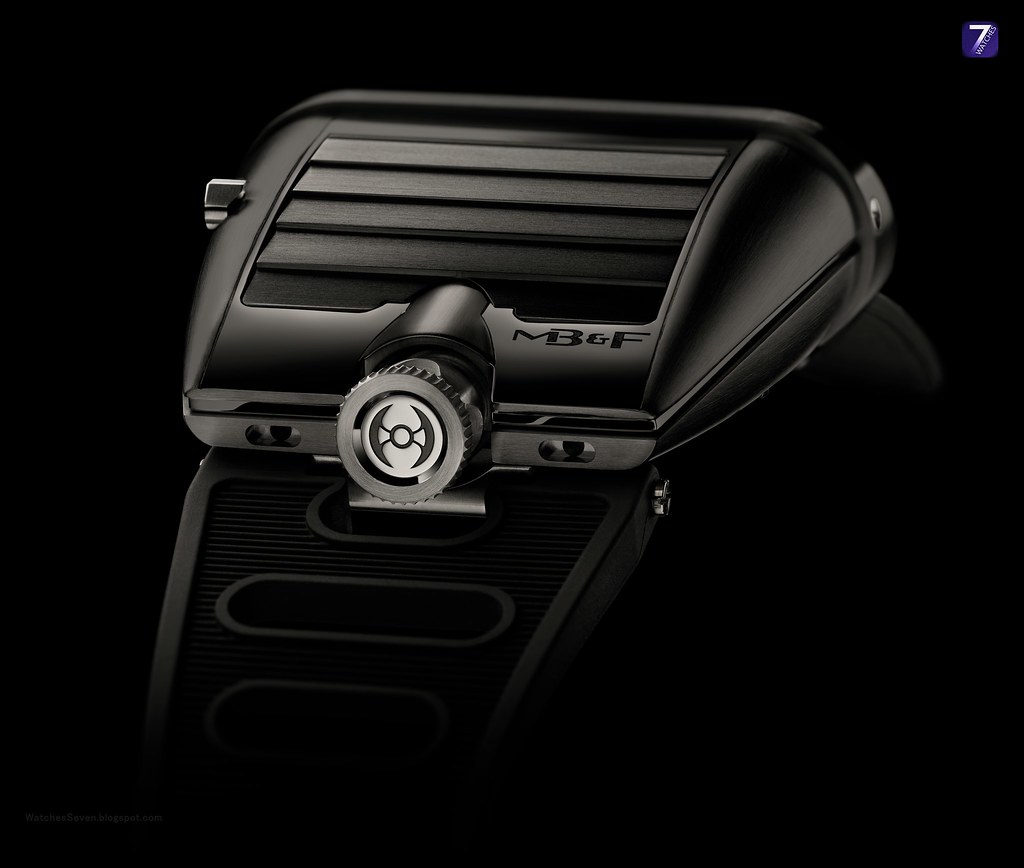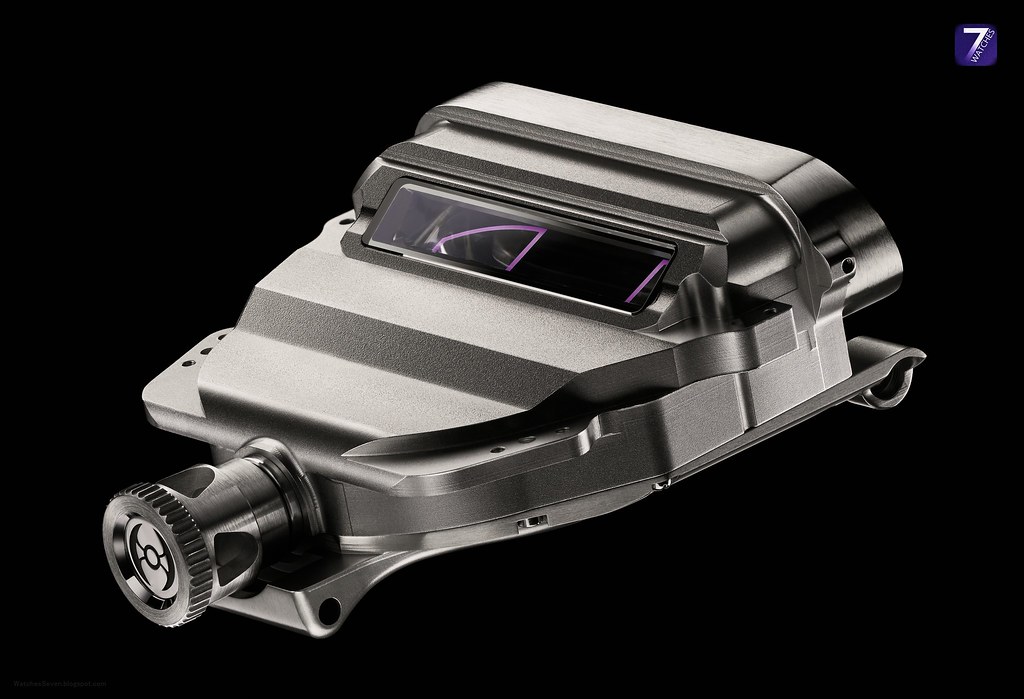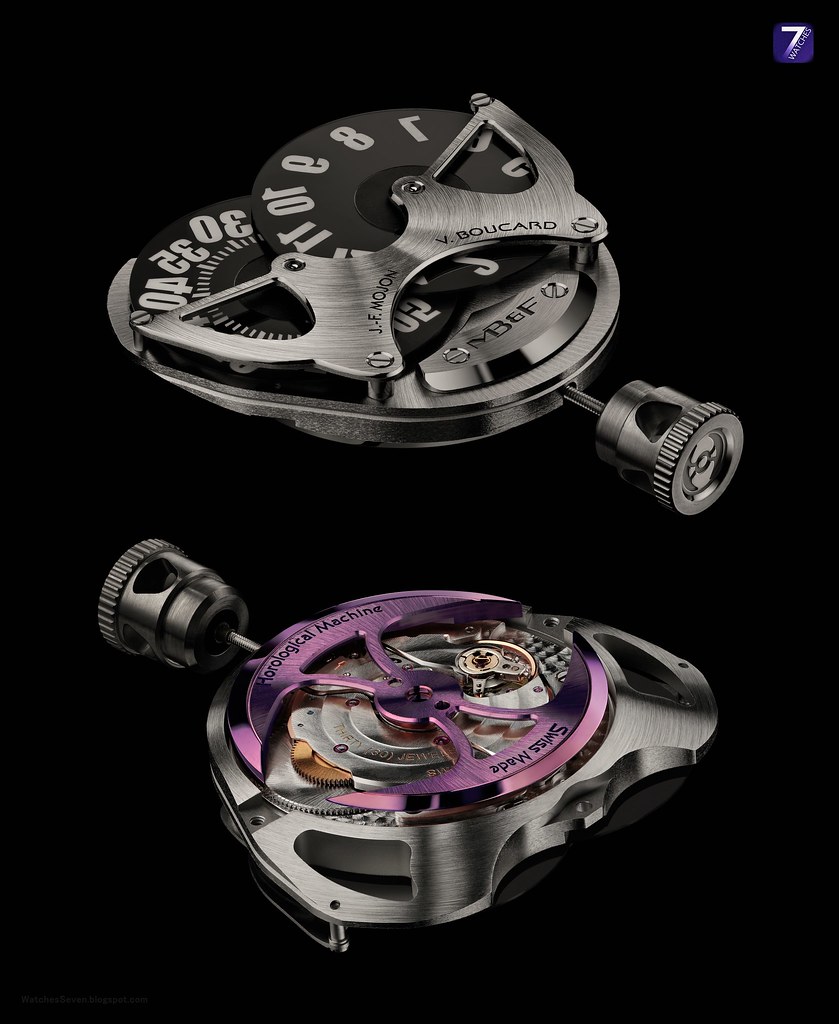MB&F – Horological Machine No. 5 CarbonMacrolon Limited Edition
THE DARK SIDE HAS NEVER LOOKED SO BRIGHT
SUMMARY
Black. As a colour, or to be more accurate, an absence of colour, there's nothing quite like it. Other colours go in and out of fashion, but black is always in. So adding a coat of black paint, a.k.a. PVD, to the case of the super-car-inspired HM5 would appear to be the sensible thing to do.
But since when has MB&F taken the sensible route?
While Horological Machine No.5’s striking, angular case architecture faithfully echoes the form of the streamlined supercars that inspired it, those sharp corners would make a black PVD coating more susceptible to being scratched than a more conventional design.
But since when has MB&F taken the sensible route?
While Horological Machine No.5’s striking, angular case architecture faithfully echoes the form of the streamlined supercars that inspired it, those sharp corners would make a black PVD coating more susceptible to being scratched than a more conventional design.
So rather than take the easier path of adding a black PVD coat to the existing HM5 case, MB&F went in search of a solid black material that:
- Could be polished and finished like metal.
- Felt as solid and substantial as metal.
- Was as hard as steel.
Click on the mouse wheel to see the large size ... BIG FOTO
It took a full 18 months, but they finally did: MB&F calls it CarbonMacrolon. CarbonMacrolon is a dense black polycarbonate resin reinforced with carbon nanotubes. It can be polished and finished like steel, feels as solid as steel and is as hard as steel. And it is black right through, so no surface coatings to scratch off.
Horological Machine No5 CarbonMacrolon (HM5 CM): Super car styling; bi-directional jumping hours, compartmentalised Engine in its own water-resistant inner case; functioning louvres allowing light in to charge the Super-LumiNova indication discs; and water-draining exhaust ports.
All this in a sleek, polished and satinised, pitch-black CarbonMacrolon case with an eye-catching iridescent purple automatic winding rotor and complementary purple highlights around the displays. Black, it’s the new black.
Click on the mouse wheel to see the large size ... BIG FOTO
MAKROLON
It’s no exaggeration to state that when Bayer introduced the revolutionary polycarbonate material Makrolon® in 1963, it changed the world. The virtually unbreakable material is used in an incredible range of diverse applications including CDs, water-resistant camera housings, medical devices, contact lenses, sunglasses, laptop cases, aircraft wing and fuselage components, canopies for jets and helicopter windscreens. With its high dimensional stability, excellent heat resistance, ease of moulding, long life and eco-friendly reusability, Makrolon® quickly became, and still is, one of the most versatile thermoplastics ever invented.
Click on the mouse wheel to see the large size ... BIG FOTO
CARBONMACROLON
Developed specifically for MB&F, CarbonMacrolon is a composite material composed of an anthracite polymer matrix injected with carbon nanotubes, which add strength and rigidity. Carbon nanotubes offer superior tensile strength and stiffness than traditional carbon fibre reinforcing. MB&F’s CarbonMacrolon is a solid black material that is heavy, hard, and can be polished and finished like metal.
Click on the mouse wheel to see the large size ... BIG FOTO

INSPIRATION AND REALISATION
For MB&F founder Maximilian Büsser, growing up as a child in the 1970s meant living in a constant state of awe and wonder. Supersonic jets flew through the air and through space; American muscle cars dominated the silver screen in road movies and fuelled the imagination.
The Lamborghini Miura launched a new genre of Italian super cars that looked as though they could break the sound barrier while standing still (creations that led the young Max to dream of being a car designer). Lasers, transistors, microwaves, hovercrafts and jet-packs gave the impression that the difference between science fiction and science fact was just a matter of when, not if.
And with the arrival of quartz wristwatches, watch designs were transformed from looking like something your grandfather wore, to something Captain Kirk might wear. HM5 takes these childhood dreams and gives them a new lease of life.
“Imagine telling somebody in 1972 that in 2012, most people would be wearing round watches with round dials and three hands. That would sound crazier and more far-fetched than the idea of living on Mars!” Maximilian Büsser
Click on the mouse wheel to see the large size ... BIG FOTO
CASE
The wedge-shaped case of HM5 has unmistakable references to the low-slung supercars of the epoch.
The purpose of the louvres on these awe-inspiring cars was to restrict sunlight (and heat) from entering the near horizontal rear window. The functional louvres on HM5 do the opposite in that they open to allow light down onto the Super-LumiNova numbers on the hours and minutes indication disks to charge them. The disks are actually flat on top of the movement (under the louvres), not vertically at the front of the case where they appear to be thanks to some optical magic. Opening and closing the louvres also changes the dial’s light intensity. The louvres are opened and closed by a slide set into the side of the case.
Another distinguishing feature of supercars are large dual exhaust pipes that are usually seen accompanied by a roar of engine noise and smoking rubber. But HM5’s exhausts are not there to expel combustion gases in a throaty roar, but to drain water in case – like James Bond’s Lotus in ‘The Spy Who Loved Me’ – HM5 gets wet.
Click on the mouse wheel to see the large size ... BIG FOTO
And no futurist icon of the 1970s is complete without a jet. HM5’s ergonomically sculptured crown looks as though it could just as easily power a rocket to the Alpha Centauri, or the Batmobile, as it powers Horological Machine No. 5 CarbonMacrolon into the future.
To minimise potential damage, the crown winding stem is guided by three radial bearings, ensuring it can only be pulled/pushed when perpendicular to the movement.
Click on the mouse wheel to see the large size ... BIG FOTO
INDICATIONS AND REFLECTIVE PRISM
The actual hour and minute time displays on HM5, i.e. the numbered rotating disks, are relatively simple: overlapping disks (one for hours, one for minutes) are completely covered in Super-LumiNova, which then has large 8mm numerals created by masking all of the lume except for the numbers.
The disks rotate flat on top of the movement and yet we see the time indications vertically in a ‘dashboard’ at the front of the case. To achieve this, MB&F worked with a high-precision optical glass supplier to develop a sapphire crystal reflective prism that bent light from the disks 90° as well as magnify it by 20% to maximise legibility.
Click on the mouse wheel to see the large size ... BIG FOTO
The sapphire prism is wedge-shaped with the angles precisely calculated to ensure that light is reflected from the horizontal indications to the vertical rather than refracted (bent). A convex lens at the front provides the magnification. Sapphire crystal is much more difficult to work to optical precision than glass and it took considerable development and meticulous care in production to create crystals that reflected and bent light without the slightest distortion.
Because the time is reflected, the numbers are printed on the disks as mirror images so that they display correctly on the ‘dial’. The glass on the front is not black but dark-tinted so that it is possible to see time arriving and departing and the numbers have an iridescent purple outline, reminiscent of the glowing instruments of a supercar on a high-speed road trip at night.
The vertical forward-facing display makes HM5 an excellent driver’s watch as there is no need to lift your wrist from the steering wheel to read the display.
Click on the mouse wheel to see the large size ... BIG FOTO
ENGINE AND INTERNAL HOUSING
As with any supercar, the best often lies under the hood and looking below the surface of the Horological Machine No. 5 CarbonMacrolon case reveals a surprise: another case! Like a Russian Matryoshka doll, peeling away the outer layer reveals a second case beneath.
The reason for housing the Engine in an inner container is for water resistance. Those supercar louvres let in water as well as light − the reason for those dual exhaust ports – so to protect the high-performance Engine from moisture as well as shocks, it is housed in its own stainless steel shell. This inner case is similar to the ridged chassis of a car on which the external coachwork/body is attached.
Click on the mouse wheel to see the large size ... BIG FOTO
Jean-François Mojon, Vincent Boucard and their team at Chronode developed the HM5 Engine/complication. It may appear simple, but it’s complicated! The jumping hours are bi-directional, enabling the time to be easily set both forwards and backwards. The two mineral glass disks of the hours and minutes are supported by a flat wide bridge. The disks overlap as much as possible to maximise their diameter and space for large legible numerals.
Turning HM5 CM over reveals the Engine, with its stunning iridescent purple 22k gold battle-axe shaped ‘mystery’ winding rotor, fast oscillating balance and stunning hand-finished bridges, visible through the sapphire crystal display back set into the water-resistant Engine container.
---------------------------------------------------
TECHNICAL SPECIFICATIONS
ENGINE (Movement)
Three-dimensional horological engine developed by Jean-François Mojon and Vincent
Boucard of Chronode
Powered by a Sowind gear train
Iridescent purple 22k gold battle-axe ‘mystery’ automatic winding rotor
Power reserve: 42 hours
Balance frequency: 28,800bph/4Hz
Number of components: 224
Number of jewels: 30
Engine housed in a water-resistant, stainless steel inner container
FUNCTIONS / INDICATIONS
Minutes and bi-directional jumping hours displayed by reflective sapphire crystal prism
with integrated magnifying lens
Slide to open/close louvres on case top
CASE
CarbonMacrolon with internal water-resistant steel engine container
Slide button to open/close louvres
Exhaust ports to drain water
Dimensions: 51.5mm x 49mm x 22.5mm
Number of components: 80
Water resistance of engine container: 30m / 90’ / 3atm
SAPPHIRE CRYSTALS
High domed sapphire crystal on top and box sapphire crystal on back,
both with anti-reflective coating on both sides.
Strap & Buckle
Sculpted rubber strap, titanium tang buckle
Limited to 66 pieces only
-------------------------------
www.facebook.com - MBandF
-----------------------------------------------
www.mbandf.com - Blog
---------------------------------------------------------
www.MBandF.com


